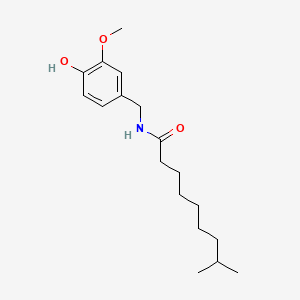| MeSH term | MeSH ID | Detail |
|---|---|---|
| Pain | D010146 | 64 associated lipids |
| Body Weight | D001835 | 333 associated lipids |
| Arthritis | D001168 | 41 associated lipids |
| Weight Gain | D015430 | 101 associated lipids |
| Tachycardia | D013610 | 7 associated lipids |
| Hypothermia | D007035 | 19 associated lipids |
| Out-of-Hospital Cardiac Arrest | D058687 | 1 associated lipids |
Capsaicin
Capsaicin is a lipid of Fatty Acyls (FA) class. Capsaicin is associated with abnormalities such as Morphologically altered structure. The involved functions are known as inhibitors, Regulation, metaplastic cell transformation, Biochemical Pathway and Uptake. Capsaicin often locates in Tissue fiber, Mucous Membrane, Nerve Endings, group Ia axon and Membrane. The associated genes with Capsaicin are TRPV1 gene, WT-1, MAP1LC3A gene, EIF2S3 gene and SLC33A1 gene. The related experimental models are Transgenic Model.
Cross Reference
Introduction
To understand associated biological information of Capsaicin, we collected biological information of abnormalities, associated pathways, cellular/molecular locations, biological functions, related genes/proteins, lipids and common seen animal/experimental models with organized paragraphs from literatures.
What diseases are associated with Capsaicin?
Capsaicin is suspected in Morphologically altered structure and other diseases in descending order of the highest number of associated sentences.
Related references are mostly published in these journals:
| Disease | Cross reference | Weighted score | Related literature |
|---|
Possible diseases from mapped MeSH terms on references
We collected disease MeSH terms mapped to the references associated with Capsaicin
PubChem Associated disorders and diseases
What pathways are associated with Capsaicin
Lipid pathways are not clear in current pathway databases. We organized associated pathways with Capsaicin through full-text articles, including metabolic pathways or pathways of biological mechanisms.
Related references are published most in these journals:
| Pathway name | Related literatures |
|---|
PubChem Biomolecular Interactions and Pathways
Link to PubChem Biomolecular Interactions and PathwaysWhat cellular locations are associated with Capsaicin?
Visualization in cellular structure
Associated locations are in red color. Not associated locations are in black.
Related references are published most in these journals:
- Am. J. Physiol. (1)
- Am. J. Physiol. Regul. Integr. Comp. Physiol. (1)
- Drug Metab. Dispos. (1)
- Others (1)
| Location | Cross reference | Weighted score | Related literatures |
|---|
What functions are associated with Capsaicin?
Related references are published most in these journals:
| Function | Cross reference | Weighted score | Related literatures |
|---|
What lipids are associated with Capsaicin?
There are no associated biomedical information in the current reference collection.
What genes are associated with Capsaicin?
Related references are published most in these journals:
- Am. J. Physiol. Regul. Integr. Comp. Physiol. (2)
- Am. J. Physiol. (1)
- Drug Metab. Dispos. (1)
- Others (1)
| Gene | Cross reference | Weighted score | Related literatures |
|---|
What common seen animal models are associated with Capsaicin?
Transgenic Model
Transgenic Model are used in the study 'In vitro hepatic and skin metabolism of capsaicin.' (Chanda S et al., 2008).
Related references are published most in these journals:
| Model | Cross reference | Weighted score | Related literatures |
|---|
NCBI Entrez Crosslinks
All references with Capsaicin
Download all related citations| Authors | Title | Published | Journal | PubMed Link |
|---|---|---|---|---|
| Gan X et al. | Potentiation of acid-sensing ion channel activity by peripheral group I metabotropic glutamate receptor signaling. | 2016 | Pharmacol. Res. | pmid:26946972 |
| Sulzberger M et al. | Effective treatment for sensitive skin: 4-t-butylcyclohexanol and licochalcone A. | 2016 | J Eur Acad Dermatol Venereol | pmid:26805417 |
| da Silva Brum E et al. | Tabernaemontana catharinensis ethyl acetate fraction presents antinociceptive activity without causing toxicological effects in mice. | 2016 | J Ethnopharmacol | pmid:27321276 |
| Abaei M et al. | Neural correlates of hyperalgesia in the monosodium iodoacetate model of osteoarthritis pain. | 2016 | Mol Pain | pmid:27068285 |
| Spaziano G et al. | Exposure to Allergen Causes Changes in NTS Neural Activities after Intratracheal Capsaicin Application, in Endocannabinoid Levels and in the Glia Morphology of NTS. | 2015 | Biomed Res Int | pmid:25866824 |
| Guo BC et al. | Transient receptor potential vanilloid type 1 is vital for (-)-epigallocatechin-3-gallate mediated activation of endothelial nitric oxide synthase. | 2015 | Mol Nutr Food Res | pmid:25581901 |
| Pinho-Ribeiro FA et al. | Protective effects of the flavonoid hesperidin methyl chalcone in inflammation and pain in mice: role of TRPV1, oxidative stress, cytokines and NF-κB. | 2015 | Chem. Biol. Interact. | pmid:25617481 |
| Nam JH and Lee DU | Inhibitory effect of oleanolic acid from the rhizomes of Cyperus rotundus on transient receptor potential vanilloid 1 channel. | 2015 | Planta Med. | pmid:25402944 |
| Torrecillas A et al. | Capsaicin Fluidifies the Membrane and Localizes Itself near the Lipid-Water Interface. | 2015 | ACS Chem Neurosci | pmid:26247812 |
| Silva DF et al. | TRPM8 Channel Activation Induced by Monoterpenoid Rotundifolone Underlies Mesenteric Artery Relaxation. | 2015 | PLoS ONE | pmid:26599698 |
